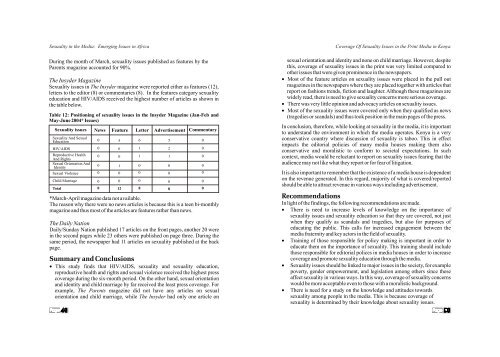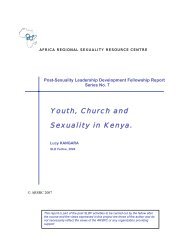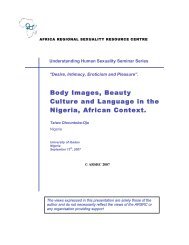Sexuality in Media: Emerging Issues in Africa - Africa Regional ...
Sexuality in Media: Emerging Issues in Africa - Africa Regional ...
Sexuality in Media: Emerging Issues in Africa - Africa Regional ...
Create successful ePaper yourself
Turn your PDF publications into a flip-book with our unique Google optimized e-Paper software.
<strong>Sexuality</strong> <strong>in</strong> the <strong>Media</strong>: Emerg<strong>in</strong>g <strong>Issues</strong> <strong>in</strong> <strong>Africa</strong><br />
Dur<strong>in</strong>g the month of March, sexuality issues published as features by the<br />
Parents magaz<strong>in</strong>e accounted for 90%.<br />
The Insyder Magaz<strong>in</strong>e<br />
<strong>Sexuality</strong> issues <strong>in</strong> The Insyder magaz<strong>in</strong>e were reported either as features (12),<br />
letters to the editor (8) or commentaries (8). In the features category sexuality<br />
education and HIV/AIDS received the highest number of articles as shown <strong>in</strong><br />
the table below.<br />
Table 12: Position<strong>in</strong>g of sexuality issues <strong>in</strong> the Insyder Magaz<strong>in</strong>e (Jan-Feb and<br />
May-June 2004* <strong>Issues</strong>)<br />
<strong>Sexuality</strong> issues<br />
<strong>Sexuality</strong> And Sexual<br />
Education<br />
HIV/AIDS<br />
Reproductive Health<br />
And Rights<br />
Sexual Orientation And<br />
Identity<br />
Sexual Violence<br />
Child Marriage<br />
Total<br />
News Feature Letter Advertisement Commentary<br />
0 5 6 5<br />
0<br />
0 6 1 2<br />
0<br />
0 0 1 1<br />
0<br />
0 1 0 0<br />
0<br />
0 0 0 0 0<br />
0<br />
0<br />
*March-April magaz<strong>in</strong>e data not available.<br />
The reason why there were no news articles is because this is a teen bi-monthly<br />
magaz<strong>in</strong>e and thus most of the articles are features rather than news.<br />
The Daily Nation<br />
Daily/Sunday Nation published 17 articles on the front pages, another 20 were<br />
<strong>in</strong> the second pages while 23 others were published on page three. Dur<strong>in</strong>g the<br />
same period, the newspaper had 11 articles on sexuality published at the back<br />
page.<br />
Summary and Conclusions<br />
• This study f<strong>in</strong>ds that HIV/AIDS, sexuality and sexuality education,<br />
reproductive health and rights and sexual violence received the highest press<br />
coverage dur<strong>in</strong>g the six-month period. On the other hand, sexual orientation<br />
and identity and child marriage by far received the least press coverage. For<br />
example, The Parents magaz<strong>in</strong>e did not have any articles on sexual<br />
orientation and child marriage, while The Insyder had only one article on<br />
0<br />
0 12 8 8<br />
0<br />
0<br />
0<br />
Coverage Of <strong>Sexuality</strong> <strong>Issues</strong> <strong>in</strong> the Pr<strong>in</strong>t <strong>Media</strong> <strong>in</strong> Kenya<br />
sexual orientation and identity and none on child marriage. However, despite<br />
this, coverage of sexuality issues <strong>in</strong> the pr<strong>in</strong>t was very limited compared to<br />
other issues that were given prom<strong>in</strong>ence <strong>in</strong> the newspapers.<br />
• Most of the feature articles on sexuality issues were placed <strong>in</strong> the pull out<br />
magaz<strong>in</strong>es <strong>in</strong> the newspapers where they are placed together with articles that<br />
report on fashions trends, fiction and laughter. Although these magaz<strong>in</strong>es are<br />
widely read, there is need to give sexuality concerns more serious coverage.<br />
• There was very little op<strong>in</strong>ion and advocacy articles on sexuality issues.<br />
• Most of the sexuality issues were covered only when they qualified as news<br />
(tragedies or scandals) and thus took position <strong>in</strong> the ma<strong>in</strong> pages of the press.<br />
In conclusion, therefore, while look<strong>in</strong>g at sexuality <strong>in</strong> the media, it is important<br />
to understand the environment <strong>in</strong> which the media operates. Kenya is a very<br />
conservative country where discussion of sexuality is taboo. This <strong>in</strong> effect<br />
impacts the editorial policies of many media houses mak<strong>in</strong>g them also<br />
conservative and moralistic to conform to societal expectations. In such<br />
context, media would be reluctant to report on sexuality issues fear<strong>in</strong>g that the<br />
audience may not like what they report or for fear of litigation.<br />
It is also important to remember that the existence of a media house is dependent<br />
on the revenue generated. In this regard, majority of what is covered/reported<br />
should be able to attract revenue <strong>in</strong> various ways <strong>in</strong>clud<strong>in</strong>g advertisement.<br />
Recommendations<br />
In light of the f<strong>in</strong>d<strong>in</strong>gs, the follow<strong>in</strong>g recommendations are made.<br />
• There is need to <strong>in</strong>crease levels of knowledge on the importance of<br />
sexuality issues and sexuality education so that they are covered, not just<br />
when they qualify as scandals and tragedies, but also for purposes of<br />
educat<strong>in</strong>g the public. This calls for <strong>in</strong>creased engagement between the<br />
media fraternity and key actors <strong>in</strong> the field of sexuality.<br />
• Tra<strong>in</strong><strong>in</strong>g of those responsible for policy mak<strong>in</strong>g is important <strong>in</strong> order to<br />
educate them on the importance of sexuality. This tra<strong>in</strong><strong>in</strong>g should <strong>in</strong>clude<br />
those responsible for editorial polices <strong>in</strong> media houses <strong>in</strong> order to <strong>in</strong>crease<br />
coverage and promote sexuality education through the media.<br />
• <strong>Sexuality</strong> issues should be l<strong>in</strong>ked to major issues <strong>in</strong> the society, for example<br />
poverty, gender empowerment, and legislation among others s<strong>in</strong>ce these<br />
affect sexuality <strong>in</strong> various ways. In this way, coverage of sexuality concerns<br />
would be more acceptable even to those with a moralistic background.<br />
• There is need for a study on the knowledge and attitudes towards<br />
sexuality among people <strong>in</strong> the media. This is because coverage of<br />
sexuality is determ<strong>in</strong>ed by their knowledge about sexuality issues.






